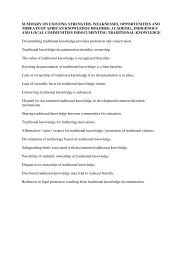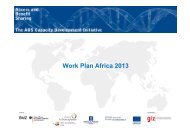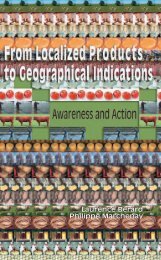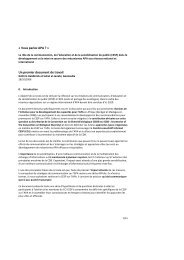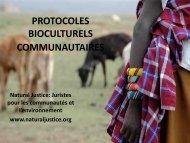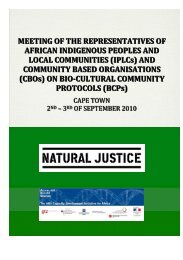The History of Farmers' Rights - Fridtjof Nansens Institutt
The History of Farmers' Rights - Fridtjof Nansens Institutt
The History of Farmers' Rights - Fridtjof Nansens Institutt
Create successful ePaper yourself
Turn your PDF publications into a flip-book with our unique Google optimized e-Paper software.
32 Regine Andersen<br />
original idea behind the plant breeders’ rights system, Butler and Pistorius<br />
maintain. <strong>The</strong> main benefit <strong>of</strong> the system would be that farmers would<br />
have the right to freely use the seed they buy.<br />
***<br />
Esquinas-Alcázar, Jose (1998): ‘Farmers’ <strong>Rights</strong>’, pp. 207–217 in R.<br />
Evenson, D. Gollin & V. Santaniello (eds) (1998): Agricultural Values<br />
<strong>of</strong> Plant Genetic Resources (Wallingford: FAO/CEIS/CABI<br />
Publishing).<br />
Esquinas-Alcázar provides an overview over the FAO negotiations on<br />
farmers’ rights, with references to the CBD and the WTO Agreement on<br />
Trade Related Aspects <strong>of</strong> Intellectual Property <strong>Rights</strong>. He maintains that<br />
implementation <strong>of</strong> farmers’ rights at the international level is vital to<br />
global equity and to halting genetic erosion in agriculture. Implementation<br />
should ensure that farmers, farming communities and their countries<br />
receive a just share <strong>of</strong> the benefits derived from the use <strong>of</strong> crop genetic<br />
resources, and provide incentives and means for the conservation and<br />
further development <strong>of</strong> these resources.<br />
***<br />
Wright, B. D. (1998): ‘Intellectual and Farmers’ <strong>Rights</strong>’, pp. 219–232<br />
in R. Evenson, D. Gollin & V. Santaniello (eds) (1998): Agricultural<br />
Values <strong>of</strong> Plant Genetic Resources (Wallingford: FAO/CEIS/CABI<br />
Publishing).<br />
In this book chapter, B. D. Wright highlights the paradox <strong>of</strong> the high total<br />
value <strong>of</strong> agricultural germplasm and the current low demand <strong>of</strong> plant<br />
breeders for such material due to their own well-stocked gene banks and<br />
the narrow genetic bases <strong>of</strong> their crop varieties. <strong>The</strong>refore any attempt to<br />
seek to earn rents on access to germplasm seems likely to fail. Against<br />
this backdrop, the author concludes that care must be taken that the<br />
exchange <strong>of</strong> seeds is not too severely hampered by taxes, fees or<br />
individualized prior approval requirements.<br />
***<br />
Gollin, D, (1998): ‘Valuing Farmers’ <strong>Rights</strong>’, pp. 233–245 in R.<br />
Evenson, D. Gollin & V. Santaniello (eds) (1998): Agricultural Values<br />
<strong>of</strong> Plant Genetic Resources (Wallingford: FAO/CEIS/CABI Publishing).<br />
This book chapter argues that there are significant potential hazards to the<br />
South in seeking to establish a system <strong>of</strong> farmers’ rights based on<br />
intellectual property rights or other forms <strong>of</strong> property rights. <strong>The</strong> point <strong>of</strong><br />
departure for the analysis are the international flows <strong>of</strong> genetic resources,<br />
which have been multi-directional between the South and the North, the<br />
South and the South, and the North and the North. Gollin proceeds to a<br />
detailed analysis <strong>of</strong> the international flows <strong>of</strong> genetic resources in rice<br />
and its implications for the question <strong>of</strong> compensation. <strong>The</strong> great majority






